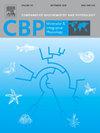Plasma steroid hormones concentrations and their relevance in the reproductive cycle of female Mountain Horned Lizard, Phrynosoma orbiculare
IF 2.2
3区 生物学
Q4 BIOCHEMISTRY & MOLECULAR BIOLOGY
Comparative Biochemistry and Physiology A-Molecular & Integrative Physiology
Pub Date : 2025-03-04
DOI:10.1016/j.cbpa.2025.111833
引用次数: 0
Abstract
Reproduction is a fundamental trait in the life history of a species; therefore, it is of great interest at all levels within a species, including the individual, ecological and conservational scope. Hormonal studies in reproduction have become relevant because of their implications on the regulation of reproductive physiology. Herein we examined hormonal profiles of progesterone (P4), estradiol (E2) and testosterone (T) of adult female Mountain Horned Lizards, Phrynosoma orbiculare, from the Parque de la Ciencia Sierra Morelos, State of Mexico, Mexico. Hormonal concentrations were measured in the plasma of adult females monthly throughout a year and linked to the reproductive cycle of the species and environmental factors [mean monthly temperature (T°), total monthly rainfall, and daylight hours representing photoperiod]. We used direct ELISA technique to assess hormonal concentrations. We report that P4 is linked to pregnancy period, as maximum values of P4 are observed during the early gestational period and decrease to minimum levels during the late pregnancy phase and near the time of birth. An increase in E2 concentration occurs after pregnancy and parallels vitellogenesis in this species. Testosterone concentrations are at maximum levels during breeding and abruptly decrease to a minimum during late pregnancy. The correlation between P4 and T is positive while the relationship between P4 and E2 is negative, but no significant correlation between E2 and T is observed. Temperature and photoperiod have a negative correlation with P4 and a positive correlation with E2, while rainfall is not supported as an important environmental factor in the regulation of these hormones. Also, T does not seem to be affected by environmental factors revised in this study. A seasonal annual steroidogenic pattern is observable in female P. orbiculare that parallels its reproductive cycle characteristics and suggests an endogenous control of reproduction. However, it appears that certain environmental conditions, such as temperature and photoperiod, may influence the reproductive rhythmicity observed in female P. orbiculare.

雌性山角蜥(Phrynosoma orbiculare)血浆类固醇激素浓度及其与生殖周期的关系
繁殖是一个物种生命史上的基本特征;因此,在一个物种的各个层面,包括个体、生态和保护范围内,它都是非常有趣的。生殖中的激素研究因其对生殖生理调节的影响而变得相关。在此,我们检测了来自墨西哥墨西哥州的Sierra Morelos公园的成年雌性山角蜥的黄体酮(P4)、雌二醇(E2)和睾酮(T)的激素谱。在一年中,研究人员每月测量成年雌性血浆中的激素浓度,并将其与物种的生殖周期和环境因素[月平均温度(T°),月总降雨量和代表光周期的日照时间]联系起来。我们使用直接ELISA技术评估激素浓度。我们报告P4与妊娠期有关,因为P4的最大值在妊娠早期观察到,并在妊娠后期和接近出生时降至最低水平。E2浓度增加发生在怀孕后,并与卵黄形成平行。睾酮浓度在繁殖期间达到最高水平,在怀孕后期突然降到最低水平。P4与T呈正相关,P4与E2呈负相关,E2与T无显著相关。温度和光周期与P4呈负相关,与E2呈正相关,而降雨不支持作为重要环境因子调控这些激素。此外,T似乎不受本研究修正的环境因素的影响。每年季节性steroidogenic模式是可观察到的在女性p . orbiculare平行其生殖周期特征,并建议了一个内生控制繁殖。然而,某些环境条件,如温度和光周期,可能会影响雌性圆圆虫的生殖节律。
本文章由计算机程序翻译,如有差异,请以英文原文为准。
求助全文
约1分钟内获得全文
求助全文
来源期刊
CiteScore
5.00
自引率
4.30%
发文量
155
审稿时长
3 months
期刊介绍:
Part A: Molecular & Integrative Physiology of Comparative Biochemistry and Physiology. This journal covers molecular, cellular, integrative, and ecological physiology. Topics include bioenergetics, circulation, development, excretion, ion regulation, endocrinology, neurobiology, nutrition, respiration, and thermal biology. Study on regulatory mechanisms at any level of organization such as signal transduction and cellular interaction and control of behavior are also published.

 求助内容:
求助内容: 应助结果提醒方式:
应助结果提醒方式:


